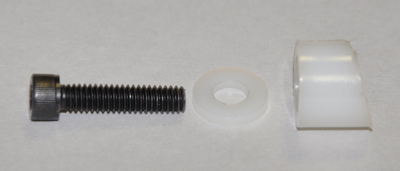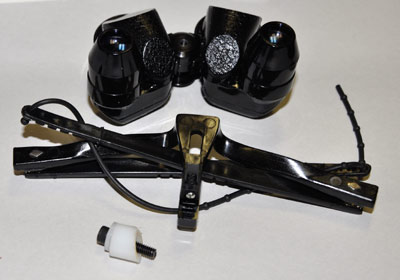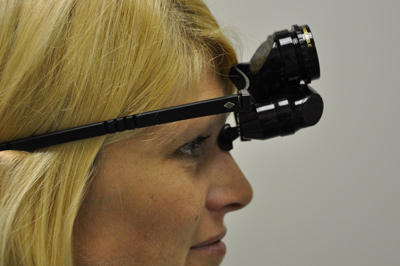The Behnke Modification of the Beecher
Researcher in Physics Helps to Modify the Beecher for Driving
Bioptic telescopes are mounted slightly angled up. The Beecher was designed with very little angle up. This works well for watching television but in driving we must have the telescope angled up so that when we tilt our head down to see through it, we will be aimed straight ahead down the road. Thus to adapt the Beecher Mirage for bioptic driving, the angle of the telescope must be changed so it tilts up about 15 to 20 degrees.
We now are modifying the Beecher Mirage for bioptic driving with the Behnke  Modification. Edward Behnke, a patient of Dr. Laura Windsor, developed it. He developed a simple solution to set the angle of the telescopes upward. Edward developed an angled nylon spacer that changes the angle of contact between the frame and the telescopic unit.
Modification. Edward Behnke, a patient of Dr. Laura Windsor, developed it. He developed a simple solution to set the angle of the telescopes upward. Edward developed an angled nylon spacer that changes the angle of contact between the frame and the telescopic unit.

The modification includes a spacer up at a 20-degree angle, a longer machine bolt and a washer. We fabricate these from nylon tube spacers. We must also change the bolt from the half-inch supplied with the Beecher to a one-inch bolt. The length of the spacer can determine how close the Beecher sits from the carrier lenses.

The angle of the cut translates to same amount of angle up for the Beecher telescopic system. The amount of the angle and width of the spacer can be changed for unusual cases such as very high set ears that force the temples up and thus tilt the Beecher down.
The finished modification results in an angle upward of the Beecher telescopes of
about 20 degrees that will make it easier for patients to shift angle of view into the Beecher telescopes.

The Behnke modified Beecher now sits with an appropriate angle up on the young lady to the right.
Edward Behnke’s simple invention should help many Beecher bioptic drivers. Ed is no stranger to invention. He is collaborating on the PICASSO Experiment, which is searching for evidence of the universe's missing matter. Ed has been credited in playing a key role in developing the amplifier that the PICASSO Experiment uses in this important dark matter research in physics.
